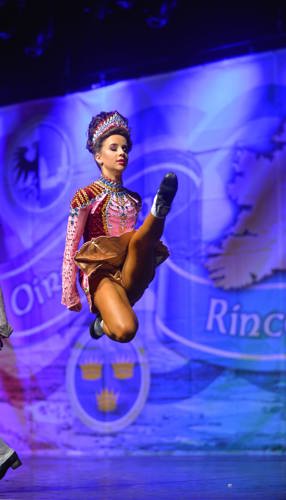Getting Jiggy with It
Author: Roisin Cahalan on behalf of the Dance Educators’ Committee
Irish dancing is one of most recognizable cultural dance genres internationally and is practiced by hundreds of thousands of enthusiasts across the globe. Although always popular in Ireland and among the Irish diaspora, Irish dancing reached a worldwide audience over 25 years ago with the success of productions such as “Riverdance” and “Lord of the Dance”. Irish dancing, unlike many other dance formats, is structured around a dense calendar of competitive events called “feiseanna”, culminating in the annual World Irish dancing championships, which features the top 5000 international qualifiers in an eight-day event.

Emily Bourke by Feisfoto
In recent decades, the complexity and physical demands of Irish dancing have increased exponentially, as has the incidence of injury in the genre. At the elite level, it is comparable to that experienced by peers from contemporary dance1 and ballet fields.2 Despite the unique choreographic features of Irish dancing, not least the upright torso and stationary arms, and the requirement to land on the toes with minimal knee bend, there are many similarities between the risks and injury profiles of elite Irish dancers and peers from other genres.1,3
The research into the causes of injury in Irish dancing is still at a relatively early stage. However, we do know that the lower limb, in particular the foot and ankle, are overwhelmingly the main body parts affected.4,5 Surprisingly, investigations of physical characteristics such as strength, endurance, balance and so on have identified few associations with injury.5,6 That is not to say that clinicians, researchers and practitioners should ignore these as potential factors. The nature of Irish dancing frequently results in muscle imbalance, with weak hip abductors and gluteal muscles, and tight hamstrings and calf muscles particularly common.7 Excellent ankle proprioception is very important due to the high level of acute ankle injury encountered.7
Load management and periodization is generally poor, with injury being associated with sudden spikes in load. There appears to be a relationship between injury and poor sleep, suboptimal general and psychological health, low mood, and increased catastrophizing.1,5,6 There is also an indication that cross training is underutilized, and there is a practice of continuing to dance even when injured or in pain.1,6 The following model identifies the myriad of factors that can threaten or protect an Irish dancer’s health and wellbeing. This is based on the research in Irish dancing, other dance genres and sport, and would apply to many elite dancers and athletes.

Cahalan, 2020
One of the most important things to remember about elite Irish dancers is that, in my experience, they share a common mind set with dancers from other genres. Dance is an integral part of their identity, and injury is a threat to the entire dancer’s sense of self. They tend to be passionate about their dancing, and some focus on the short term as opposed to employing strategies to support healthy longevity in dance. Irish dancers need to be treated holistically, with SMART goal setting and careful monitoring to support progress in performance or when injured. For more on the management of the elite Irish dancer, see “The Complete Irish Dance” Facebook page and YouTube channels, which are packed with easily accessible resources for anyone working with these athletes.
References
- Cahalan R, Kearney P, Ni Bhriain O, Redding E, Quin E, McLaughlin LC, O’Sullivan K. (2018). Dance exposure, wellbeing and injury in collegiate Irish and contemporary dancers: A prospective study. Physical Therapy in Sport. https://doi.org/10.1016/j.ptsp.2018.09.006
- Cahalan, R. and O'Sullivan, K. (2013a) 'Injury in Professional Irish Dancers', Journal of Dance Medicine & Science, 17(4),150-158.
- Higginbotham O, Cahalan R (2020). The collegiate Irish dancer's experience of injury: A qualitative study. Medical Problems of Performing Artists. https://doi.org/10.21091/mppa.2020.1001
- Cahalan, R., O'Sullivan, K., Purtill, H (2017). Biopsychosocial Factors Associated with Foot and Ankle Pain and Injury in Irish Dance: A Prospective Study. Medical Problems of Performing Artists. 32(2),111-117.
- Cahalan, R., O'Sullivan, K., Purtill, H. Bargary N., Ni Bhriain O. and O'Sullivan, P. (2015). ‘Inability to perform due to pain/injury in elite adult Irish dance: A prospective investigation of contributing factors’, Scandinavian Journal of Medicine and Science in Sports, 26(6), 694–702. doi: 10.1111/sms.12492
- Cahalan R, Bargary N, O’Sullivan K. 2019. Dance exposure, general health, sleep and injury in elite adolescent Irish dancers: A prospective study. Physical Therapy in Sport, 40: 153-159. https://doi.org/10.1016/j.ptsp.2019.09.008
- Cahalan et al; 2020. Complete Irish Dancer: Optimization of Health and Performance in Irish Dancers. Chapter 2. Nova Sports Publishers, New York, USA. ISBN: 978-1-53617-389-5.